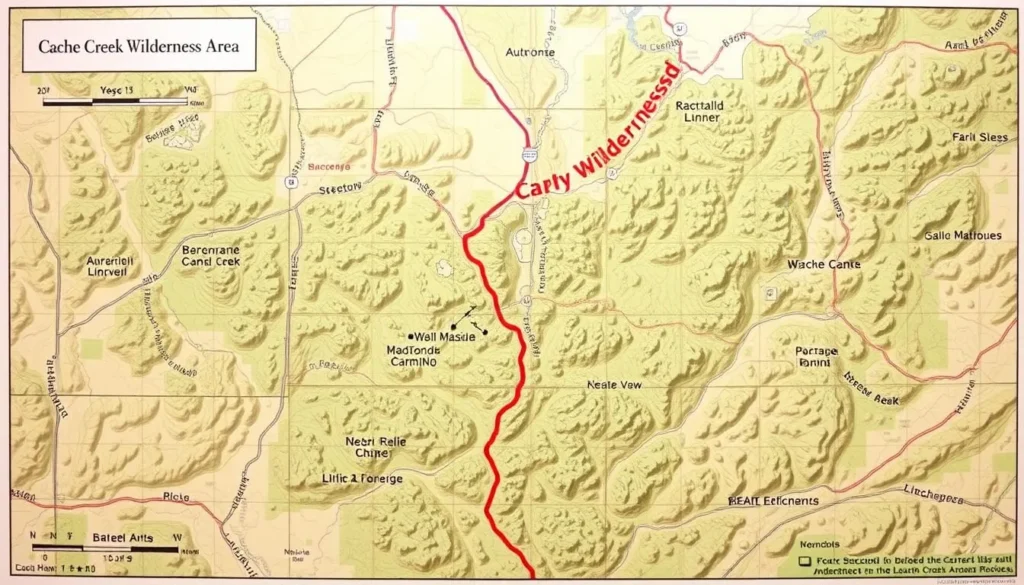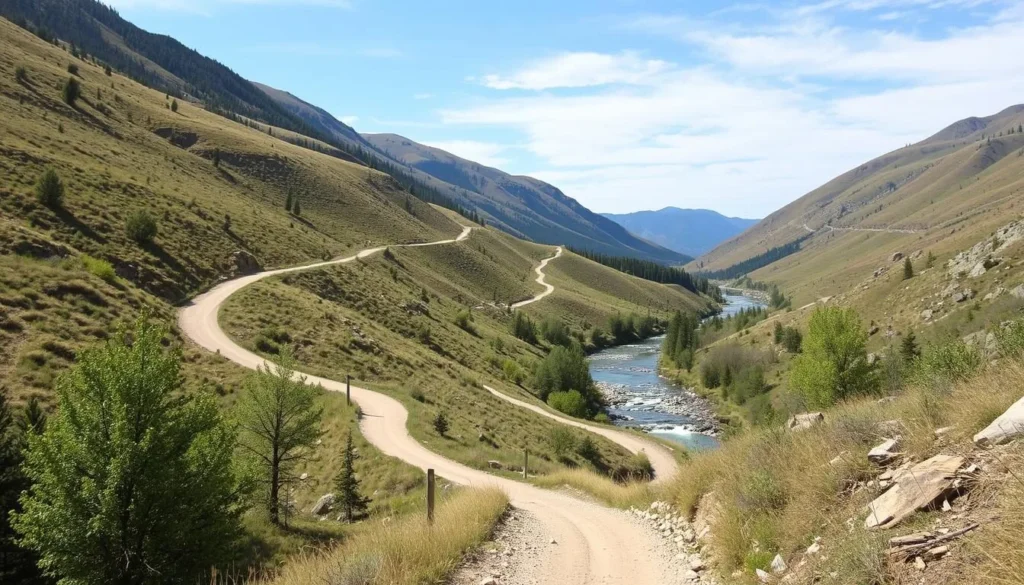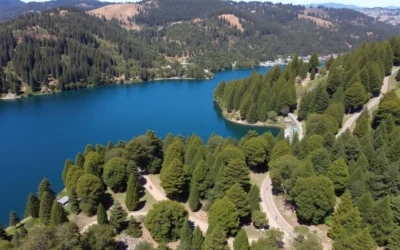✓ Accommodations ✓ Flights ✓ Rental Cars
Nestled in the beautiful coastal mountains of California, the Cache Creek Wilderness Area offers an unforgettable outdoor experience. With its diverse landscape of oak-studded hills, flowing creeks, and seasonal wildflowers, this 27,294-acre wilderness area is a haven for nature enthusiasts.
As you explore the scenic hiking trails and enjoy peaceful water activities, you’ll discover why this area has become a favorite among backpackers and nature lovers alike. Whether you’re planning a day trip or a multi-day adventure, the wilderness area promises an escape from the crowds and a chance to reconnect with nature.
Discovering Cache Creek Wilderness Area
As you step into the Cache Creek Wilderness Area, you’ll discover a world of rolling hills, oak woodlands, and riparian corridors. This wilderness area, located in the California Coastal Range, offers a unique blend of natural beauty and adventure.
Location and Overview
The Cache Creek Wilderness Area is situated in California, providing an accessible escape into nature for both locals and visitors. To plan your visit, you can explore more details about the area.

The area is characterized by its lower elevation, making it accessible year-round, though it can get particularly hot during the summer months. This characteristic, combined with its diverse landscape, makes it an attractive destination for various outdoor activities.
Natural Features and Landscape
The Cache Creek Wilderness Area boasts a classic California landscape, featuring:
- Rolling hills and oak woodlands that create a visually stunning environment.
- Significant seasonal variations, transforming the area dramatically throughout the year.
- Cache Creek as the central natural feature, providing essential water resources.
- A topography that ranges from gentle valleys to steep ridges, with elevations between 1,000 to 2,500 feet above sea level.
- Spectacular wildflower displays in the spring, with numerous native California wildflower species.
The combination of these natural features and the area’s rugged character creates a lush environment, making it a unique spot within the California Coastal Range.
Top Hiking and Backpacking Trails in Cache Creek Wilderness Area Lakes, California: Best Things to Do – Top Picks
For those seeking adventure, the Cache Creek Wilderness Area is a treasure trove of hiking and backpacking opportunities. With its diverse landscapes and challenging trails, this area is perfect for outdoor enthusiasts looking to explore California’s natural beauty.
Redbud Trail Experience

The Redbud Trail offers a unique hiking experience, with its picturesque surroundings and moderate difficulty level. This trail is ideal for those looking to immerse themselves in nature without the challenge of a strenuous hike.
Trail Highlights: Enjoy the vibrant colors of the redbud trees, especially during spring. The trail’s relatively flat terrain makes it accessible to hikers of various skill levels.
Judge Davis Trail Highlights

The Judge Davis Trail is another gem within the Cache Creek Wilderness, offering hikers a chance to experience the area’s diverse flora and fauna. This trail is known for its scenic views and historical significance.
Notable Features: The trail follows Cache Creek, providing beautiful water views and opportunities to spot local wildlife. Its historical markers add an educational element to the hike.
Ridge Loop Adventures
The Ridge Loop Trail is designed for more experienced hikers, offering a challenging adventure with significant elevation changes. This loop provides breathtaking views of the surrounding wilderness and is ideal for those seeking solitude.
Key Features: The trail includes several seasonal creeks, diverse wildlife, and panoramic views from the ridges. It’s customizable for various lengths, making it suitable for both day hikes and multi-day backpacking trips.
Water Activities and Wildlife Viewing
The Cache Creek Wilderness Area offers a diverse range of activities, from exciting water adventures to serene wildlife viewing opportunities. As you explore this beautiful region, you’ll find numerous ways to engage with nature, whether you’re looking for thrilling experiences or peaceful moments of observation.
Cache Creek Water Adventures

Cache Creek is renowned for its rafting opportunities, offering exciting experiences for visitors. The creek’s waters provide a thrilling adventure for those who enjoy rafting and other water activities. With its scenic surroundings, Cache Creek is an ideal location for outdoor enthusiasts looking to combine adventure with nature appreciation.
Seasonal Wildflowers and Oak Forests
The Cache Creek Wilderness Area is also known for its vibrant seasonal wildflowers and lush oak forests. During the spring, the area comes alive with a variety of wildflowers, creating a picturesque landscape. The oak forests provide a habitat for a range of wildlife, adding to the area’s natural beauty and biodiversity.
Wildlife Spotting Opportunities
The Cache Creek Wilderness Area provides excellent wildlife viewing opportunities, with diverse habitats supporting a wide range of native California species. You can spot black-tailed deer, tule elk, and various raptor species, including golden eagles and red-tailed hawks. Early morning and evening hours are ideal for wildlife sightings, as animals are most active during these times.
To maximize your chances of spotting wildlife, bring binoculars and move quietly along trails. The riparian corridors along Cache Creek are particularly rich in wildlife, attracting various bird species, reptiles, and mammals. Spring visitors often enjoy increased wildlife activity as animals emerge from winter patterns and begin breeding seasons.
Practical Tips for Your Cache Creek Wilderness Visit
To make the most of your visit to Cache Creek Wilderness, you’ll need to be prepared with the right information and gear. The area is at a lower elevation and can get hot in the summer, making spring (March-May) and fall (September-November) the best times to visit.
You’ll need to obtain current information and maps from the Ukiah Field Office of the Bureau of Land Management, which manages the wilderness area and can provide updates on trail conditions, water availability, and any special notices. Access to the wilderness is available through several entry points, with Cowboy Camp serving as a popular trailhead located approximately 8 miles east of Clearlake Oaks on Highway 20.
Water management is essential for your trip. While Cache Creek and some seasonal streams provide water sources, you should always carry sufficient water (at least 2-3 liters per person per day) and treat all wilderness water before drinking. Remember that motorized vehicles and equipment are prohibited within wilderness boundaries, so all exploration must be done on foot.
For overnight trips, dispersed camping is permitted throughout most of the wilderness area, though you should camp at least 200 feet from water sources. The best day hikes for first-time visitors include the 4-mile round trip from Cowboy Camp to Wilson Valley. Cell phone coverage is extremely limited or non-existent throughout most of the wilderness area, so you should bring paper maps, a compass, and consider carrying a satellite communication device for emergencies.
If you’re planning a multi-day backpacking route, consider the loop options that combine the Redbud Trail, Judge Davis Trail, and Ridge Loop for a comprehensive 20-30 mile experience that showcases the best of the wilderness area over 2-3 days.
The above is subject to change.
Check back often to TRAVEL.COM for the latest travel tips and deals.





